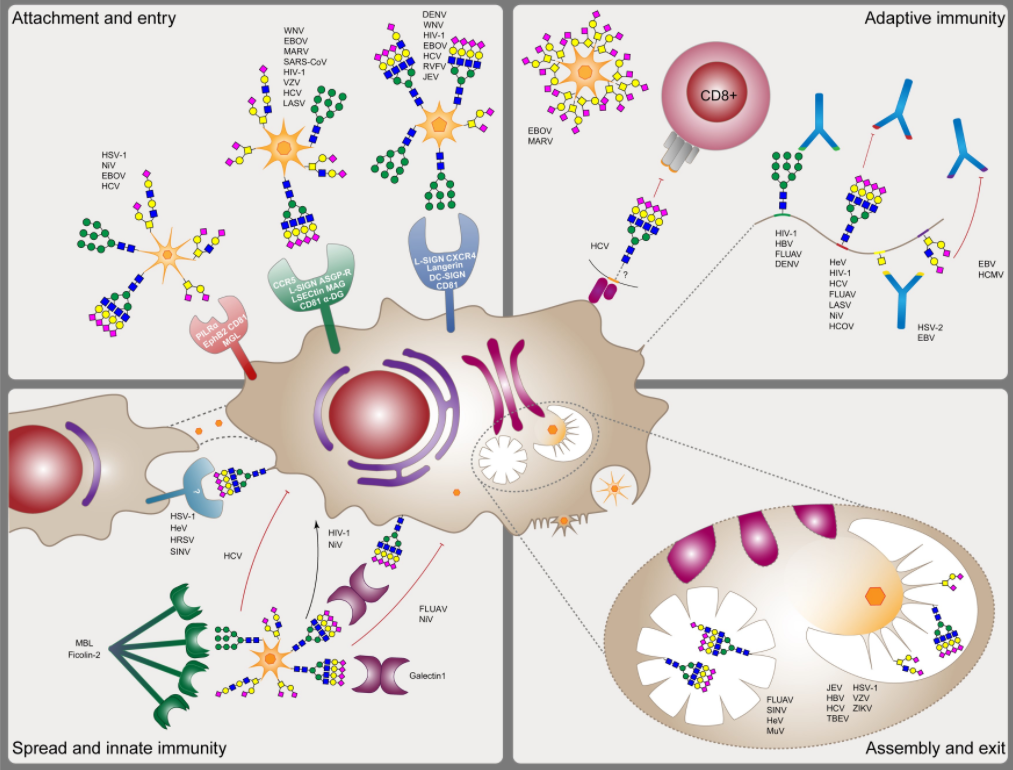Antiviral Drug Development
Nowadays, the traditional antiviral drugs commonly used are amantadine (one of Ion channel blockers) and ribavirin (a kind of nucleoside-analogue antiviral drug). They inhibit the replication and transmission of the virus through different mechanisms. However, those drugs often cause adverse reactions such as gastrointestinal and neurotoxic side effects, and the resistance that viruses develop is tricky. Recently, with the deepening understanding of enveloped virus glycoproteins and glycans, research and development of antiviral drugs that target enveloped virus glycoproteins have become a hot topic.
Roles of glycosylation in the biology of enveloped viruses, including
- Participate in recognition between viruses and their host receptors
- Influence the virus replication cycle
- Influence the release of the virions and virus transmission
- Affect virulence/pathogenicity of the virus
 Fig1. Roles of glycosylation in the biology of enveloped viruses.( Bagdonaite, I., & Wandall, H. H., 2018)
Fig1. Roles of glycosylation in the biology of enveloped viruses.( Bagdonaite, I., & Wandall, H. H., 2018)
Application of glycosylation function for antiviral drug development
Considering the important role of glycans and glycoproteins in the biology of enveloped viruses, the use of these molecules as drug targets in the process of antiviral therapy has attracted much attention, and has been proved by many related studies and used in antiviral research.
Human immunodeficiency virus 1 (HIV-1)
The interactions between glycans and lectins play important roles in the process of viral infections, and these interacting molecules can be used as drug targets. It is reported that HIV-1 infection can be inhibited by lectins. Lectins directly bind to the viral glycans, disrupting the receptor-induced conformational changes, inhibiting membrane fusion, thereby blocking the binding of Dendritic cell-specific ICAM-3 grabbing nonintegrin (DC-SIGN). In addition, tetherin can inhibit the spread of HIV by retaining virions on the surface of the infected cell. Tetherin is a protein on the surface of human cells and its antiviral activity is reported to be related to its glycosylation. There are two putative N-linked glycosylation sites on tetherin, at least one of which is critical for preventing HIV transmission.
SARS-CoV-2
Kifunensine, one of the mannosidase-I inhibitors, can inhibit the biosynthesis of N-glycan and promote proteolysis of S proteins. Therefore, this glycosylation Inhibitor reduces receptor-binding domain presentation on SARS-CoV-2 pseudovirus and the binding to host receptor angiotensin-converting enzyme 2 (ACE2), resulting in reduced viral entry. Besides kifunensine, swainsonine, a mannosidase II inhibitor can also inhibit the biosynthesis of N-glycan and has been reported to be safe in humans, which may be applied to reduce viral entry. Moreover, iminosugars are known inhibitors of α-glucosidase I (αGI) and α-glucosidase II (αGII), including castanospermine and celgosivir. Notably, they can significantly inhibit SARS-CoV-2 replication in cell culture. Thus, these compounds can be applied to reduce viral load and relieve SARS-CoV-2 related respiratory symptoms.
Based on interfering with the mutual recognition process of glycan and lectin, there are other potential inhibitors that can be used to modulate viral entry, such as carbohydrate-based small molecules and acceptor decoys. Creative Proteomics is an international contract research organization (CRO) providing a series of viral glycoproteomics services. we are dedicated to providing a range of services tailored to meet our customers' needs. Feel free to contact us with your inquiries about viral glycoproteomics.
References
- Bagdonaite, I., & Wandall, H. H. (2018). “Global aspects of viral glycosylation.” Glycobiology, 28(7), 443-467.
- Li, Y., et. al. (2021). “The Importance of Glycans of Viral and Host Proteins in Enveloped Virus Infection.” Frontiers in Immunology, 12, 1544.
Related services
* For research use only.

 Fig1. Roles of glycosylation in the biology of enveloped viruses.( Bagdonaite, I., & Wandall, H. H., 2018)
Fig1. Roles of glycosylation in the biology of enveloped viruses.( Bagdonaite, I., & Wandall, H. H., 2018)